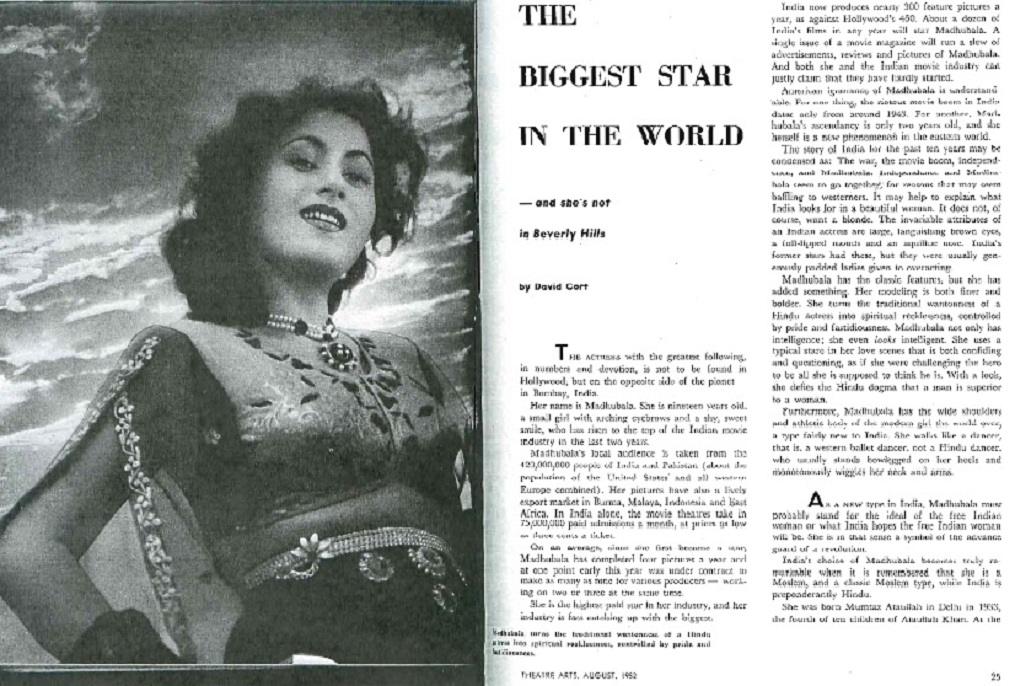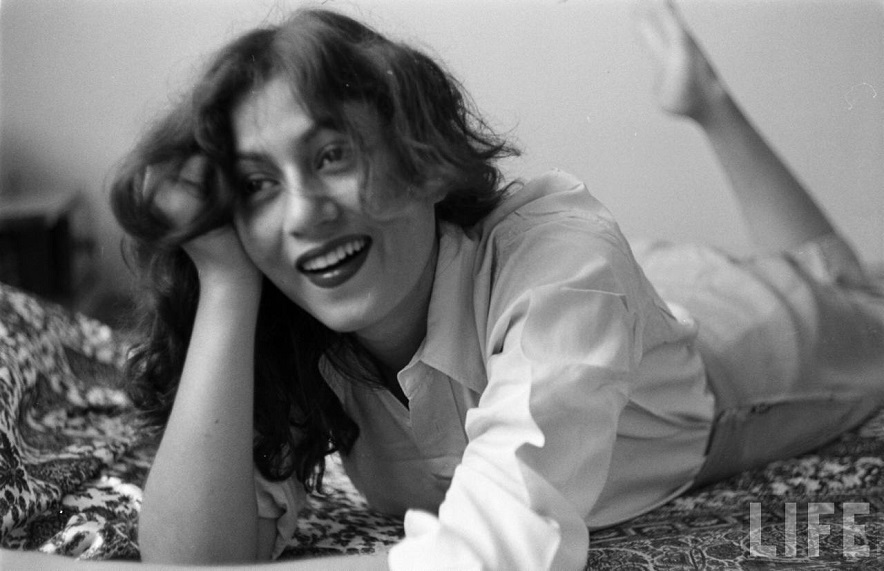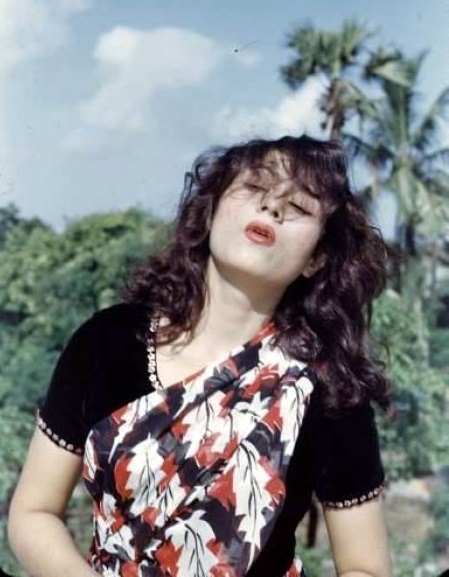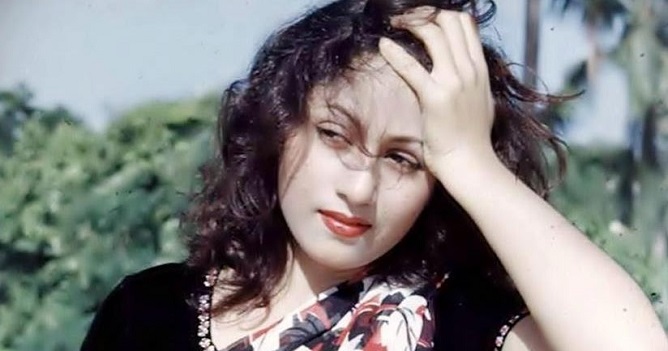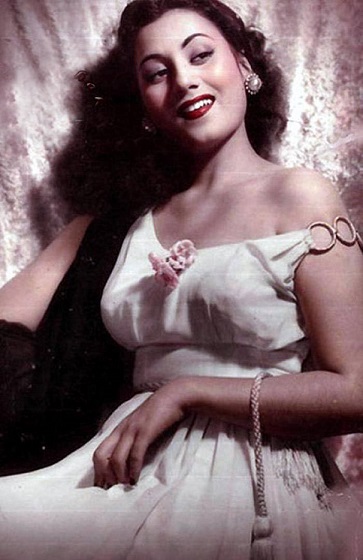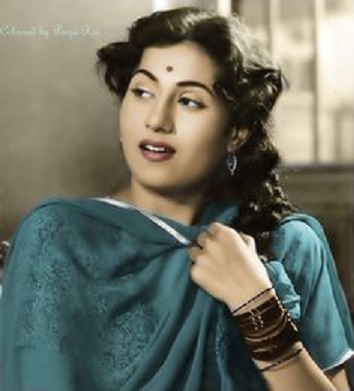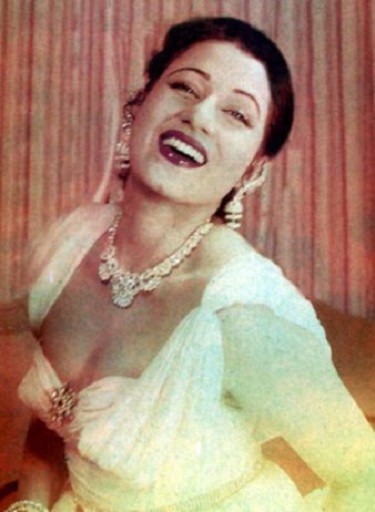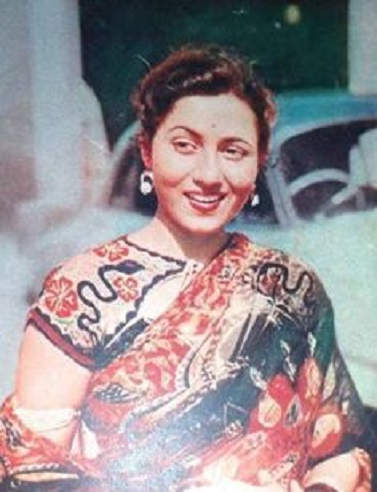Madhubala, actress
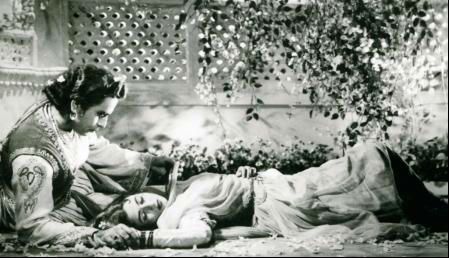
This is a collection of articles selected for the excellence of their content.
|
Contents |
Biography
Vital statistics
Born February 14, 1933, Delhi
Died February 23, 1969 ,Bombay
Name at Birth: Mumtaz Jehan Dehlavi (later, Begum…)
Actress Devika Rani gave her the screen name Madhubala.
Height 5' 4" (1.63 m)
Her prolonged, nine-year illness: caused by heart disease (a hole in the heart).
Career
Debut in Filmistan: 1939 Swastik (at age 6)
First lead role, at age 14: Neel Kamal (1947), produced, directed by Kidar Sharma
First major hit: Mahal (1949).
Family
Father: Attaullah Khan.
Sisters: Kainz Balsara, Altaf Kowal, Chanchal Ibrahim, Shahida Kazi, Madhur (Zahida) Bhushan (a playback singer and wife of Brij Bhushan Sahni).
Sister took the screen name "Ganga" and debuted in Hum Do Daku.
Relationships
She was wooed by Bharat Bhushan, Pradeep Kumar and Kishore Kumar.
She wooed Dilip Kumar, with whom she had a seven-year relationship.
Married Kishore Kumar, who converted to Islam for this.
Subhash K. Jha's biography
Magical Madhubala
By Subhash K. Jha or LMN or both Sentinel Assam
The name itself invokes so many enigmas, that it’s just overwhelming! Venus of the east, the most beautiful woman to adorn the Hindi film screen, Madhubala represents the era of beauty, romance and sometimes tragedy associated with Hindi films.
Born Mumtaz Jehan Begum Dehelvi in a poor Pathan Muslim family in 1933, she made her debut as a child artiste in the early 40’s, she never looked back and though huge success eluded her for a while, it was Mahal which released in 1949 that made her a star forever.
Madhubala was 17 when she became a star and her aura in the film Mahal has spell binding capability. Ayega Aanewal she sung on screen, and froze one of the most glorifying moments of Hindi film history, a moment portraying timelessness of beauty in the purest form.
Her beauty had child like quality, fragile yet confident. Her luminous eyes, her royal gait and that bewitching smile makes her the best poster picture one can imagine. For years I have noticed most beauty parlours adorning her on their walls as if endorsing their beauty business by the symbol of beauty itself. Madhubala was actress par excellence too, only she was not credited initially when her films flopped in the 50s (Tarana, Sangdil and Amar) could not meet box office success and she was labelled a jinx. Later, she however bounced back with a row of hit and memorable films culminating finally into the biggest film of Hindi cinema Mughal-E-Azam that truly made her a legend for her talent and not just beauty.
It’s often when a woman is too beautiful, her beauty distracts from her performances. Whenever I watch a Madhubala film I’m spellbound by her beauty so much that it’s hard to notice her great performance. In Guru Dutt’s Mr.& Mrs.55 there is this scene when some street kids find her near Guru Dutt’s apartment (she is a rich woman dressed well), and mistake her to be a ‘fairy’, they do not want to come near fearing that the ‘fairy’ may disappear. This particular scene truly describes her persona. She was so very beautiful that she seemed surreal and one would be so stunned to see her that going near her other aspects was difficult. Such was the effect.
She is well remembered for her role in Howrah Bridge where she played a seductress and the song Aayiye Meharbaan is perhaps amongst her most enchanting one’s.
Madubala had brilliant comic timing and could easily match pace with Kishore Kumar too. Her role in Mr & Mrs 55 also showcased her comic talent, so did Half Ticket and Chalti Ka Naam Gaadi.
Madubala was sadly diagnosed to have a heart condition at the peak of her career and she sadly could not continue to work. Also she went through heartbreak when her romantic relationship with Dilip Kumar could not culminate in a marriage. Dilip Ji and Madhubala will always remain a dream pair on Indian Screen, their chemistry was just too perfect, they just lighted up in each other’s presence and it’s so evident on screen. The feather sequence in Mughal-E-Azam will remain one of the most romantic moments of Hindi film history and Pyar Kiya To Darna Kya one of the best known dance sequence. She brought Anarkali alive in the most beautiful manner and immortalized her forever in our minds and hearts.
She was known to be a through professional, punctual, with no starry airs she was known to have a child like demeanour and loved playing pranks and spreading smiles around her. Despite her heart condition she quietly let herself be chained with heavy iron ones for a sequence in Mughal-E-Azam, feeding in to her perfectionist director without complaining, though she was in great pain.
It is said she really wanted to have a happy family and made an attempt at it by marrying Kishore Kumar who converted to Islam to marry her, but the cruel hands of fate were already grabbing her. She did undergo a Cardio Thorasic surgery, but it was to no avail. The Venus was ready to immortalise herself in her death too which came far too prematurely at the age of 36 in 1969. The world lost her to enigma, to the mystery of fate and it’s cruel hands grabbing the most beautiful woman in the prime of her youth.
But Madhubala has already etched herself in our hearts will always remain there forever. (LMN)
Idolised around the world
Hollywood desires Madhubala
In 1951, celebrity photographer James Burke came to India to shoot a mesmerising session with Madhubala for Life magazine. Theatre Arts magazine in the August 1952 issue, featured her as, “The Biggest Star in the World - and she’s not in Beverly Hills”. Hollywood biggies clamoured to cast her. Filmmaker Frank Capra, besotted by her beauty, tried to cast her when he visited Mumbai for a film festival. But allegedly her father Attaullah Khan refused all the offers. (Filmfare )
The Biggest Star in the World – and she’s not in Beverly Hills
David Cort, LIFE magazine, August, 1952
The actress with the greatest following, in numbers and devotion, is not to be found in Hollywood, but on the opposite side of the planet — in Bombay, India.
Her name is Madhubala. She is nineteen years old, a small girl with arching eyebrows and a shy, sweet smile, who has risen to the top of the Indian movie industry in the last two years.
Madhubala’s local audience is taken from the 420,000,000 people of India and Pakistan (about the population of the United States and all western Europe combined). Her pictures have also a lively export market in Burma, Malaya, Indonesia and East Africa. In India alone, the movie theatres take in 75,000,000 paid admissions a month, at prices as low as three cents a ticket.
On an average, since she first became a star, Madhubala has completed four pictures a year and at one point early this year was under contract to make as many as nine for various producers — working on two or three at the same time.
She is the highest paid star in her industry, and her industry is fast catching up with the biggest.
India now produces nearly 300 feature pictures a year, as against Hollywood’s 450. About a dozen of India’s films in any year will star Madhubala. A single issue of a movie magazine will run a slew of advertisements, reviews and pictures of Madhubala. And both she and the Indian movie industry can justly claim that they have hardly started.
American ignorance of Madhubala is understandable. For one thing, the riotous movie boom in India dates only from around 1943. For another, Madhubala’s ascendancy is only two years old, and she herself is a new phenomenon in the eastern world.
The story of India for the past ten years may be condensed as: The war, the movie boom, independence, and Madhubala. Independence and Madhubala seem to go together, for reasons that may seem baffling to westerners. It may help to explain what India looks for in a beautiful woman. It does not, of course, want a blonde. The invariable attributes of an Indian actress are large, languishing brown eyes, a full-lipped mouth and an aquiline nose. India’s former stars had these, but they were usually generously padded ladies given to overacting.
Madhubala has the classic features, but she has added something. Her modeling is both finer and bolder. She turns the traditional wantonness of a Hindu actress into spiritual recklessness, controlled by pride and fastidiousness. Madhubala not only has intelligence; she even looks intelligent. She uses a typical stare in her love scenes that is both confiding and questioning, as if she were challenging the hero to be all she is supposed to think he is. With a look, she defies the Hindu dogma that a man is superior to a woman.
Furthermore, Madhubala has the wide shoulders and athletic body of the modern girl the world over, a type fairly new to India. She walks like a dancer, that is, a western ballet dancer, not a Hindu dancer, who usually stands bowlegged on her heels and monotonously wiggles her neck and arms.
AS A NEW type in India, Madhubala must probably stand for the ideal of the free Indian woman or what India hopes the free Indian woman will be. She is in that sense a symbol of the advance guard of a revolution.
India’s choice of Madhubala becomes truly remarkable when it is remembered that she is a Moslem, and a classic Moslem type, while India is preponderantly Hindu.
She was born Mumtaz Ataullah in Delhi in 1933, the fourth of ten children of Ataullah Khan, At the age of six, she was spotted by a movie producer, given the name of Madhubala and a small part; at a wage of $45 a month. This prospect of added income induced her father, when she was nine, to move his family to Bombay, the center of India’s movie industry.
An atmosphere of sheer nightmare quickly closed in on the family. Almost immediately the dock explosion and fire of April 14, 1944, (a historic date in India) wiped out their home and possessions. Appropriately, the family escaped death or injury because they had been to the movies, at a theater distant from the scene of the disaster.
In 1947 came the tragic communal disorders, during which the Hindus drove 6,000,000 Moslems out of India, massacring half a million and abducting thousands of women. Madhubala and her sisters knew they were among the hunted. But by this time she had acted in five pictures for Ranjit Movietone, in the last one as a star, and her position probably saved the family.
It is a measure of India’s ability to grow in tolerance that, as it became more used to freedom, it reversed itself and chose to love the Moslem Madhubala. However, anti-Moslem prejudice must continue to be one of her chief problems. She is the victim of a whispering campaign that accuses her, for example, of eating the meat of the cow, which is sacred to Hindus. To offset such rumors she gave her life savings of 50,000 rupees to the Bengal Refugee Fund last winter to help Hindu refugees from Moslem East Pakistan. Her friends said that this proved her “a real daughter of Mother India.” Her enemies turned the gift against other Moslem stars: “Why not also Dilip Kumar, Nargis, Suraiya, Yaqub? Or are they hoarding money to be sent to Pakistan?”
Madhubala’s private life is in marked contrast to the roles she plays in the movies. Most often, though not invariably, she takes the part of a bad girl. The typical Indian plot casts her as a rich and frivolous heiress pursuing a poor but noble youth. India is more and more freely borrowing themes from such Western plays as Smilin’ Through and Pygmalion.
Madhubala has a delicately sensuous figure. The movie magazines have called her “the Venus of the screen.” The advertisements for one picture sarcastically show her cowering under the waving hoofs of a rearing stallion. It should be added, however, that a kiss or any extensive exposure of the female person is never permitted in an Indian movie.
The biggest star in the world has one final perfection in her name. The “bala” part is only a feminine ending, but “Madhu” means variously “fragrant,” “spring,” and “love.” It seems curiously right that free India should have chosen to worship an actress named “fragrant spring of love.”
The New York Times’ tribute
AISHA KHAN | 1933-1969: Madhubala | The New York Times
A Bollywood legend whose tragic life mirrored Marilyn Monroe’s.
It was probably the first ghost story in Indian cinema. A bewildered young man in a mansion chasing glimpses of an ethereal, veiled beauty. The movie, “Mahal,” was a huge success, making the lead actress, Madhubala, who was barely 16, a superstar overnight.
Nearly seven decades later, strains of the film’s signature song, “Aayega aane wala” (He will come), are instantly recognizable to most Indians, evoking the suspenseful tale of lost love and reincarnation.
Madhubala’s tragic turn in the film as an enigmatic young woman in search of love seemed to foreshadow her own glittering but short life. She died 20 years later as an icon of beauty and tragedy — her dazzling career, unhappy love life and fatal illness more dramatic than any movie she starred in.
Asked once to describe herself, Madhubala said she was so young when she entered the “maze” of the film industry — she made her debut at 9 — that she had lost herself.
“When you have forgotten yourself, what can you tell people about yourself?” she once said.
Besotted poets called her “a living Taj Mahal,” but Madhubala’s radiant beauty was not cold or forbidding. Her dreamy eyes, vivacious smile and mischievous laughter gave her a girl-next-door appeal.
She has been compared to Marilyn Monroe: the smoldering looks, the short career, the tragic end. “There was a remarkable similarity in the soft vulnerability of their faces,” writes Khatija Akbar in her biography of Madhubala. “The same abandon to their laughter, head thrown back, that same incandescent glow.”
Starting in the late 1940s — in a newly independent India finding its place in the world — Madhubala often portrayed modern young women testing the limits of traditions. Her roles “embodied the optimism of a new generation which was rather consciously moving away from its colonial past,” write Nupur Sharma and Inam Abidi Amrohvi, independent journalists researching Hindi cinema.
Unlike other actresses of her time, she wasn’t typecast. Her natural, understated acting style brought her equal success in serious social dramas like “Amar” (Eternal) and in lighthearted comedies and period pieces.
She could play with equal ease a spoiled heiress in “Mr. and Mrs. 55” (1955), a reporter investigating a murder in “Kala Pani” (Exile, 1958), and a rebellious woman whose car breaks down in the comedy “Chalti Ka Naam Gaadi” (If It Ain’t Broke, 1958).
Younger Indians may not have seen all her films, but in Bollywood, an industry that churns out musicals, Madhubala is associated with dozens of iconic songs: a flirty number in “Howrah Bridge” (1958), a folk song in “Phagun” and an ode to love in “Barsaat Ki Raat” (A Rainy Night, 1960). Though like most Indian actors, she was only lip-syncing.
Madhubala’s movies were also hits abroad, even in faraway places like Greece. Theater Arts, a New York magazine published from 1916 to 1964, called her “the biggest star in the world.” Life sent a photographer to profile her.
Frank Capra Jr., visiting Bombay for a film festival in 1952, was said to have offered her a job in Hollywood. But Madhubala’s father, who controlled her career, forbade it.
Despite her success and the breadth of her work, Madhubala’s acting skills were still underappreciated. She never won any awards, even for her biggest hits.
“Everyone went on about how beautiful she was, but she really held her own against some acclaimed actors,” said Tejaswini Ganti, an associate professor of anthropology at New York University who studies Bollywood.
Madhubala (Muh-DHOO-baa-laa) was born Mumtaz Begum on Feb. 14, 1933, in Delhi to a poor Pashtun family. Her father moved the family to Bombay, where they lived in a shantytown that happened to be near the Bombay Talkies film studio. Mumtaz caught the eye of the studio’s co-founder, Devika Rani, who later gave her the name Madhubala, or honeybelle.
Madhubala was soon known for her fastidious work ethic — on set at 6 a.m., no matter what. She took on as many films as possible, to support her family. She had already appeared in 17 films by the time she starred in “Mahal” (Mansion), one of nine movies she made in 1949.
She was born with a ventricular septal defect, a hole in her heart, diagnosed after she began working. There was no treatment for her condition, and she continued her punishing pace, completing more than 70 films in her short career. She told a friend: “No sooner had I learned what I was doing, God said, ‘Enough.’ ” Madhubala and Dilip Kumar in the 1960 film “Mughal-e-Azam,” the most expensive Indian movie of its time. It was colorized and re-released in 2004. Ronald Grant Archive/Alamy
Madhubala was uninhibited for an Indian actress of that time. She was playful and flirtatious, and made news for her dalliances. “Tarana” (Anthem, 1951) paired her with the star Dilip Kumar, who played a doctor who fell for Madhubala’s feisty village girl. She was immediately smitten with Kumar, 10 years her senior, and reportedly sent him a rose, the beginning of a long romance.
The two were the talk of film magazines, and fans loved their pairing. “She lived a far more liberal lifestyle than most Indian women, with romance itself an act of subversion in a conservative society,” Sharma said.
Kumar recommended Madhubala as his co-star for “Mughal-e-Azam” (“The Great Mughal”), based on the legend of a romance between the Mughal prince Salim and a dancer, Anarkali.
The director was K. Asif, whose painstaking vision made it the most expensive Indian movie of its time, and for years, the most successful.
One of its most memorable sequences, the only one originally filmed in color, is a dance in a hall of mirrors, faithfully recreated from a Mughal palace. A defiant Anarkali declares her love before the disapproving Emperor Akbar with a daring refrain: “I have only fallen in love, I have nothing to fear.”
In keeping with the era, the two lovers barely embrace, let alone kiss. Yet, a scene when Salim caresses Anarkali’s face with a feather is considered one of the most erotic in Indian cinema. But by the time the scene was filmed (the movie took about a decade to make), the two were long estranged, according to Kumar.
They had been eager to marry, but Madhubala’s father had set conditions, including that they star in movies he would produce. Kumar demanded that she choose between him and her father. She chose her family. An ugly lawsuit over another movie hastened their breakup.
“The romance that wasn’t realized was the big story of her life, which added to her legend,” Ganti said.
Once, asked her thoughts on love, Madhubala said: “No peace or happiness is possible in life without true love.”
In 1960, the year “Mughal-e-Azam” was finally released, she married her frequent co-star Kishore Kumar, a talented singer. While their pairing in a string of comedies was cinema gold, offscreen the two were quickly estranged.
Madhubala made a few more hit movies, but her health deteriorated rapidly, and she spent her last years at home, out of the public eye. In her final days, according to her sister, Madhubala would say: “I want to live. Please God, let me live.” She died on Feb. 23, 1969, nine days after her 36th birthday.
Aisha Khan is an assistant editor at The Times. The first Indian movie she ever saw was “Mother India.” Her capsule review: “Heartbreaking.”
An icon in Greece
Sanghamitra Mazumdar | When Greece fell in love with Madhubala | February 14, 2018 | Indian Express
Hindi films have always enjoyed a fan following across the world. Decades ago, Raj Kapoor used to be a household name in Russia, and songs like Awara Hun and Mera Joota Hai Japani picturised on him are still popular in that country. Amitabh Bachchan is one of the most popular stars in Egypt, while Peru, Germany, Nigeria go gaga for Shah Rukh Khan. Aamir Khan’s Dangal is still breaking records in China. There are several countries where Bollywood broke language and culture barriers and reigned supreme for decades.
Greece, for example, was one country that connected with India through its Hindi films and the music in them. Greek educationist Helen Abadzi had written a thoroughly researched article around a decade ago on how Hindi movies conquered Greece around 1960, millania after Alexander the Great conquered northwest India.
And one of the stars who ruled the Greek hearts was our very own Madhubala, one of the most beautiful actresses of all time.
Madhubala became so popular in Greece in the late 1950s and early 1960s that the European country made the “Venus of Indian cinema” immortal by dedicating a song to her in its own language. Sung by popular Greek singer Stelios Kazantidis, the song is a tribute to Madhubala’s ethereal beauty, her poise and grace. While it is not clear who wrote it — Kazantidis himself or a female lyricist Eftihis Papayiannopoulou — the composition belongs to the Rebetico/Laiko genre of Greek music.
In her article, ‘When India Conquered Greece: Hindi Films of the 50s in Greece’, Abadzi writes how Greece fell in love with Hindi movies, their music, and actors.
The economic condition of Greece was bleak in the early 1950s, and World War II and a subsequent civil war had destroyed the countryside and killed many inhabitants. There was a climate of desperation and it was then that Hindi movies made an indelible impression, she writes.
Most of the Hindi movies made during the time were love stories set in a background of tangled family relations, poverty, exploitation, and misery with the plot interspersed with songs and dances. madhubala photos Madhubala in the movie Mughl-E-Azam.
“The plots of the movies resonated with the wounded Greek psyche. Suffering women, street children who had to drop out of school, jealous sisters-in-law, vengeful mothers-in-law, interdependencies, betrayals, and frequent unhappy ends resonated with the difficult choices of poorly educated Greek people subsisting in large cities. In particular, the characters appealed to poor women. The maidservants and factory workers saw themselves depicted on the movie screen, hoping for deliverance,” Abadzi writes.
According to her, Mother India, Awaara and other movies established Nargis as the great priestess of the family dramas, with Madhubala a close second. “The ability of these heroines to express pain made the beautiful and haunting songs that they sang instant hits. It was only natural that the emotions of the poor Greeks would be expressed through those very same melodies,” she writes.
Starting in 1959, many Hindi songs had their Greek versions sung by established artistes. While ‘Madhubala’, also known as ‘Mandoubala’, was a specific work dedicated to the beautiful actress, most of the over 110 Greek numbers were inspired from popular Hindi songs.
The Madhubala song is a lover’s cry for his beloved whom he has lost. It was a huge hit and has remained popular to this date. The song is also lovingly hummed in Cyprus, which speaks Greek. Loosely translated, part of the lyrics will mean something like this:
“I wish I could see you and then die, my dear.
My soul wants only this.
Since I lost you, I’m melting,
I cry out your name with pain,
Mahdubala, Mahdubala.”
At least seven versions of this song are available on YouTube.
Her films
Bollywood’s iconic beauty and talent, Madhubala, would have turned 85 had she been alive. On her birthday today, here’s a look at what made her so special, her life’s tragedies and her work.
Beauty So striking was her beauty that famous film journalist BK Karanjia had declared that ‘none of her published photographs did full justice to her quite extraordinary beauty’. Her co-stars would often talk of her admiringly. Dev Anand was once quoted as saying “statuesque is the word I would use for her”. Baburao Patel, editor and publisher of FilmIndia, both feared and respected by the film industry, had dubbed her the ‘Venus of the Indian Screen’.
Madhubala and Dilip Kumar first worked together in a film called Tarana (1951).
Declining health Her marriage to Kishore Kumar (they remained married for nine years) was equally problematic. It has been alleged that she got married to him on a whim that she could get any man she desired. Whatever the reason, the union was an unhappy one and some say the principle reason was her declining health. Madhubala suffered from an incurable health problem – she had a hole in her heart. The condition is called ventricular septal defect in medical terms, in which the body produces extra blood. It has been reported that she would often bleed from her nose and mouth. A doctor would routinely come to her home to extract blood from her body. By early 1960s, the condition went from bad to worse. Her health affected her mood and it is alleged that she and Kishore often fought and she mostly lived in her father’s home. Her end came in 1969, aged 36.
Her iconic roles
Mahal (1948)
Any compilation of the best works of Madhubala would be incomplete with the mention of Mahal. This Kamal Amrohi-directed reincarnation drama, starring Ashok Kumar and Madhubala, is, of course, famous for its haunting melody, ‘Aayega, Aayega Aane Wala’. However, what many may not know is that the character of Kamini/Asha that Madhubala essayed in the film was quite far removed from a screen image of the vivacious beauty. Playing a ghost, her imagery was, perhaps, the first of what would become the template of Hindi film female ghost. Though Kamini never wore a white sari but as it was the black-and-white era, we will never know what colour she actually wore. Her character, we come to know later, is not a ghost but a woman who feigns being a ghost to have her way. She actually goads the man she loves to kill.
Kala Pani (1958)
Based on a novel called Beyond This Place by Scottish writer AJ Cronin, Kala Pani was about a son who goes looking for his father, jailed for a criminal offence. Not convinced of the charges against him, the son digs deep into the case and with the help of a news reporter and a prostitute is able to nab the real culprits and set his father free. While the plot was centred around Dev Anand’s character, Madhubala as a young news reporter too shone in a small part. Of course, the song ‘Achha Ji Main Haari, Chalo Maan Jao Na’ is hugely popular to this day.
Howrah Bridge (1958)
This Shakti Samanta film was also an urban murder mystery with drama thrown in. Here again, while the film was about a character played by Ashok Kumar, Madhubala as the Anglo Indian bar singer Edna was absolutely stunning. Her popular song ‘Aayiye Meherbaan’ remains an eternal favourite. Playing Edna who sings at the bar, Madhubala refined sensuality on Indian screen. As she flirted innocently with the camera, several generations of India men swooned over her.
Mr and Mrs 55 (1955)
Madhubala was the queen of comedy. Small wonder then that in her body of work, comedies far outnumber any other genre of acting. As the spoiled heiress to a fortune that her greedy aunt wants to usurp, Madhubala was in her elements. As part of the will her deceased father has left behind, Madhubala’s character must marry. An over enthusiastic aunt (played by the veritable Lalita Pawar) devises a way -- first get her married and then have her divorced in order to lay her hands on her wealth. The aunt arranged for a guy, played by Guru Dutt, who is a struggling cartoonist. The sham marriage turns into a relationship when, after enough drama, Madhubala’s character realises that her place is with her husband. As a spoiled heiress who turns into a good housewife, the role gave Madhubala a lot of scope to act and, needless to say, she excelled in it.
Barsaat Ki Raat (1960)
The Bharat Bhushan and Madhubala-starrer was a love story but is said to be well ahead of its times. Of particular mention were its female characters, who are shown to be independent and strong women, capable of taking their own decisions. Madhubala plays the daughter of a police commissioner who falls in love and then elopes with a singer, against her father’s wishes. The conflict shown in the film has more to do with the complexity between the lovers, instead of struggle between parents and their children and the choices the latter make. The film also glorifies singing girls, otherwise a taboo subject. Madhubala, as the beloved who runs away but later have issues with her beloved put up a spirited performance, one that needs to be applauded.
Mughal-e-Azam (1960)
The crowning glory in her short career will, of course, be Mughal-e-Azam. The film, which took inordinately long time to be made, was quite simply a clash between Madhubala’s Anarkali and Prithviraj Kapoor’s Akbar. As a rebel who will stand up to a much stronger opponent, Anarkali was riveting. And while the story of the doomed love between courtesan Anarkali and Mughal scion Salim had been made before on the silver screen too (Bina Rai-Pradeep starrer Anarkali in 1953), it is K Asif’s masterpiece which is best remembered. And much of the credit goes to its lead actors. It is said that the classic scene when Dilip Kumar caresses Madhubala with a feather was shot when the relationship between the two had soured so much that weren’t even greeting each other! Yet, how that scene has captured the imagination of the world!
In her life as in her death, Madhubala had the ability to capture people’s imagination. So much so that even Hollywood director Frank Capra wanted to cast her in a film. That, of course, is another story.
Filmography
As an actress
As a child star
1939 Swastik
1942 Basant
1944 Mumtaz Mahal
1945 Dhanna Bhagat
1946 Phoolwari
1946 Pujari
1946 Rajputani
1947 Chittor Vijay
1947 Dil-Ki-Rani (Sweet-Heart)
1947 Khubsoorat Duniya
1947 Mere Bhagwan
In leading roles
1947 Neel Kamal
1947 Saat Samundaron Ki Mallika
1948 Amar Prem
1948 Desh Sewa
1948 Lal Dupatta
1948 Parai Aag
1949 Apradhi
1949 Daulat
1949 Dulari
1949 Imtihaan
1949 Janmapatri
1949 Mahal
1949 Neki Aur Badi
1949 Paras
1949 Singaar
1949 Sipahiya
1950 Beqasoor
1950 Hanste Aansoo
1950 Madhubala
1950 Nirala
1950 Nishana
1950 Pardes
1951 Aaram
1951 Badal
1951 Khazana
1951 Nadaan
1951 Nazneen
1951 Saiyan
1951 Tarana
1952 Sangdil
1952 Saqi
1953 Armaan
1953 Rail Ka Dibba
1954 Amar
1954 Bahut Din Huwe...
1955 Mr. & Mrs. '55
1955 Naata
1955 Naqab
1955 Teerandaz
1956 Dhake Ki Malmal
1956 Raj Hath
1956 Shirin Farhad
1957 Ek-Saal
1957 Gateway of India
1957 Yahudi Ki Ladki
1958 Baghi Sipahi
1958 Chalti Ka Naam Gaadi
1958 Howrah Bridge
1958 Kala Pani
1958 Phagun
1958 Police
1959 Do Ustad
1959 Insan Jaag Utha
1959 Kal Hamara Hai
1960 Barsaat Ki Raat
1960 Jaali Note
1960 Mehlon Ke Khwab
1960 Mughal-e-Azam
1961 Boy Friend
1961 Jhumroo
1961 Passport
1962 Half Ticket
1964 Sharabi
1971 Jwala
As a producer
1955 Naata (‘presentation producer’)
1960 Mehlon Ke Khwab
As a singer
Passport (Sun le dastañ yooñ na sataa)
See also
Dilip Kumar: his films, their box office performance, awards, career
Madhubala, actress
